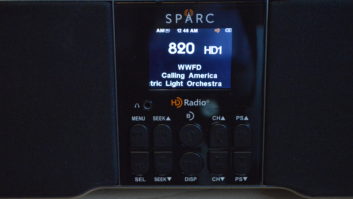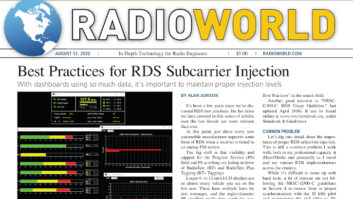
More all-digital AM IBOC tests are anticipated this year.
Initial tests were completed in November and December by a group of engineers from NAB Labs, CBS Radio and iBiquity Digital, with assistance from Harris Broadcast Communications and Kintronic Labs. The results have yet to be made public. The aim of the testing was to verify whether the AM signal coverage and robustness are improved with an all-digital signal and to quantify any change.
While NAB Labs is cautiously optimistic about the results, its head, NAB Executive Vice President/Chief Technology Officer Kevin Gage, tells me the initial findings need to be corroborated. Hence the need for more trials, to get repeatable results and to test the all-digital AM IBOC signal, both indoor and outdoor coverage — day and night — on stations in various locations using various power levels and equipment configurations.
Members of the Digital Radio Subcommittee of the National Radio Systems Committee received a briefing on the initial tests at CES in January; the NAB Radio Board was briefed shortly after. There will be a paper about the testing at the spring NAB Broadcast Engineering Conference, given by David Layer, senior director of advanced engineering at NAB. That session is slated for Monday, April 8 at 4 p.m., when presumably more details of the test results will be revealed.
For indoor tests, the group used an Insignia Narrator receiver. Mobile tests were also conducted, with the all-digital signal turned on and off for both.
The test station was CBS-owned WBCN(AM), Charlotte, N.C., a 10 kW day/1 kW night non-directional at 1660 kHz. WBCN was chosen because CBS Radio volunteered it, Gage told me, though engineers from radio groups other than CBS attended the tests. In an interview, he said a handful of stations have volunteered for the next round; he couldn’t say specifically how many stations are needed because the test plan was still being defined as of mid-February.
The next round of tests may occur by early in the second quarter. However, “There’s nothing final, and that can change rapidly,” he said.
MUCH TO EXPLORE
Sources have expressed a range of descriptions when they characterize the results to me. One said they were good, another that the WBCN results were “nearly flawless.”
Gage was more cautious, saying only that the all-digital at least matches the analog contour. He stressed several times that the test results need to be corroborated. Noting that WBCN is on the expanded band portion of the AM dial, he said the results were “positive enough for us to move forward with the next round of testing so we can see the effect across the entire band.”
That’s in line with what one engineer suggested when I reported on these developments recently on the Radio World website. “Digital AM should be tested on complex directional arrays, like WXYT(AM), Detroit, as well as on the omnidirectional so-called ‘graveyard’ channels such as 1230 kHz,” the engineer wrote.
NAB Labs is moving forward with defining a complete test bed, said Gage, who calls himself a “constructive destructor.” His job is like that of a technology scout for the broadcast lobby, to look forward and anticipate how broadcasters can remain relevant and provide products consumers want. Once getting the okay from the board, NAB Labs can move forward with test locations based on its requirements, he added.
Within the test group, broadcast engineering consultant Dennis Wallace of Meintel, Sgrignoli and Wallace was among those participating for NAB Labs. CBS Radio Senior Vice President of Engineering Glynn Walden helped establish the test plan and observed the daytime testing; Market Engineering Manager Alan Lane took part as well, especially preparing the transmitters before testing. IBiquity Digital Field Test and Implementation Manager Russ Mundschenk also participated.
OPTIONS DISCUSSION
The FCC in 2002 approved implementation of the so-called “hybrid” HD Radio technology, meaning that U.S. AM and FM radio stations could broadcast digital on their existing frequencies, along with their analog signals, if they wished. Going “all-digital,” in either band, was seen as an option for a distant future, one that would require further regulatory changes.
It’s been some 10 years since there was any testing of the all-digital AM IBOC system. Should the agency ever approve implementation of all-digital AM IBOC, it would first need data about the technology’s performance. Proponents hope the information gleaned from tests would help to establish interference criteria and allocation rules.
Meanwhile, though much industry attention in recent years has focused on digital FM power levels and digital data, IBiquity officials recently told me they’re making incremental improvements in the AM system, including working on better antenna solutions.
Going all-digital with AM is one of several AM technical improvements mentioned in a report from the NAB Technology Committee to the NAB board. The report has never been released publicly. When asked about that, NAB spokesman Dennis Wharton said ultimately it will be the board’s decision, but “it’s not envisioned to be released in its current form.” Last fall I reported that several engineers told me the report would need to be revised for consumption by a non-technical audience.
Gage confirmed NAB Labs has several radio and television projects underway, including AM initiatives, as well as software development projects, but he declined to elaborate.
I’ve been asked why is NAB is being so “opaque” about the AM issue. To get stuff done is the short answer. A longer answer would be: To get stuff done in an environment where ideas and projects can be encouraged and honestly debated — and sometimes fail — in private, rather than in an arena in which ideas are instantly criticized, causing people to stop contributing their thoughts. Or so several sources tell me.
Certainly, the possibility of someday allowing AMs to go all-digital is controversial; and NAB has radio group members both big and small who don’t agree on any best course for the future of AM, let alone on all-digital AM technology. However shining a light on the process couldn’t hurt and might even help the cause.
As to the industry’s ability to understand the technical options: If the NAB board can understand them, I suspect the radio industry can. By waiting several months to release details, NAB gives the impression that decisions are made by a select group and provides fuel for those who trash anything IBOC-related.
Whether the report is released soon may become moot, though, because Commission Ajit Pai and others are now bringing more of those options into the public’s view on their own. It will be interesting to see what he and the panelists have to say on their session on AM initiatives at the upcoming NAB Show.







